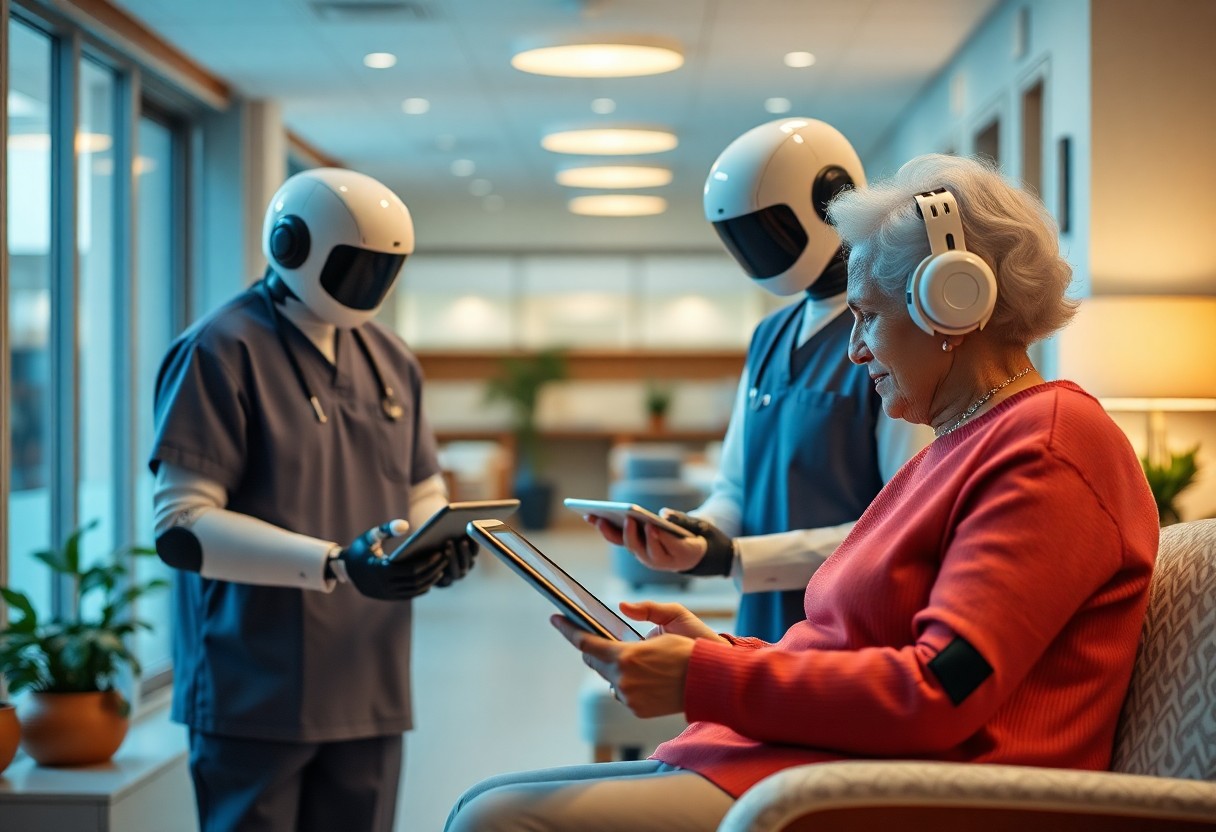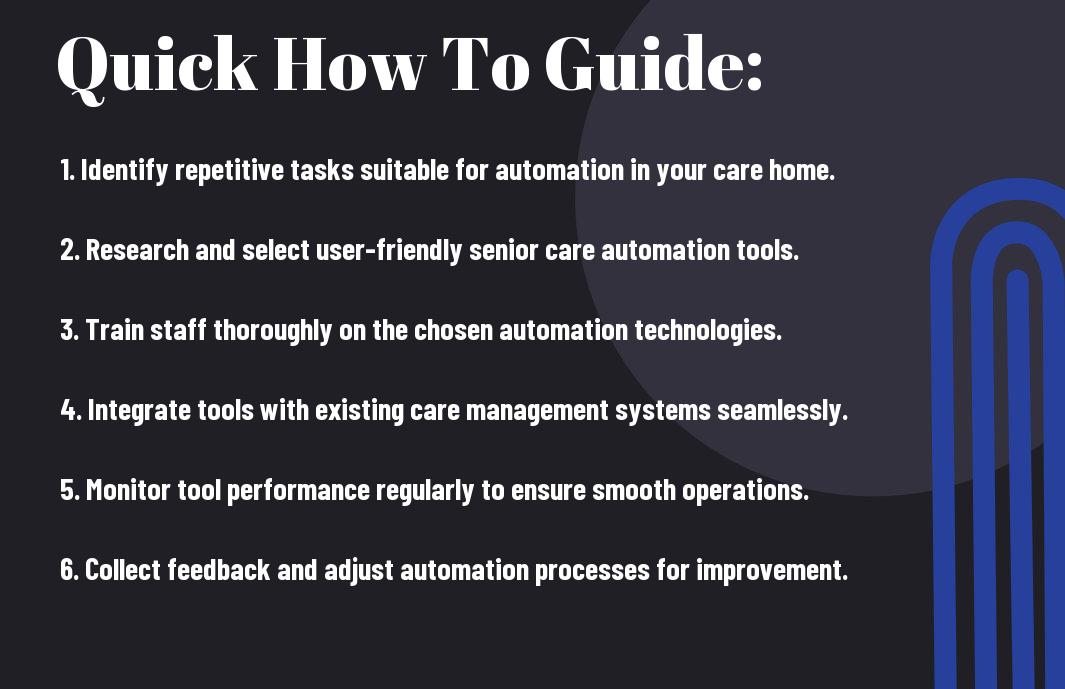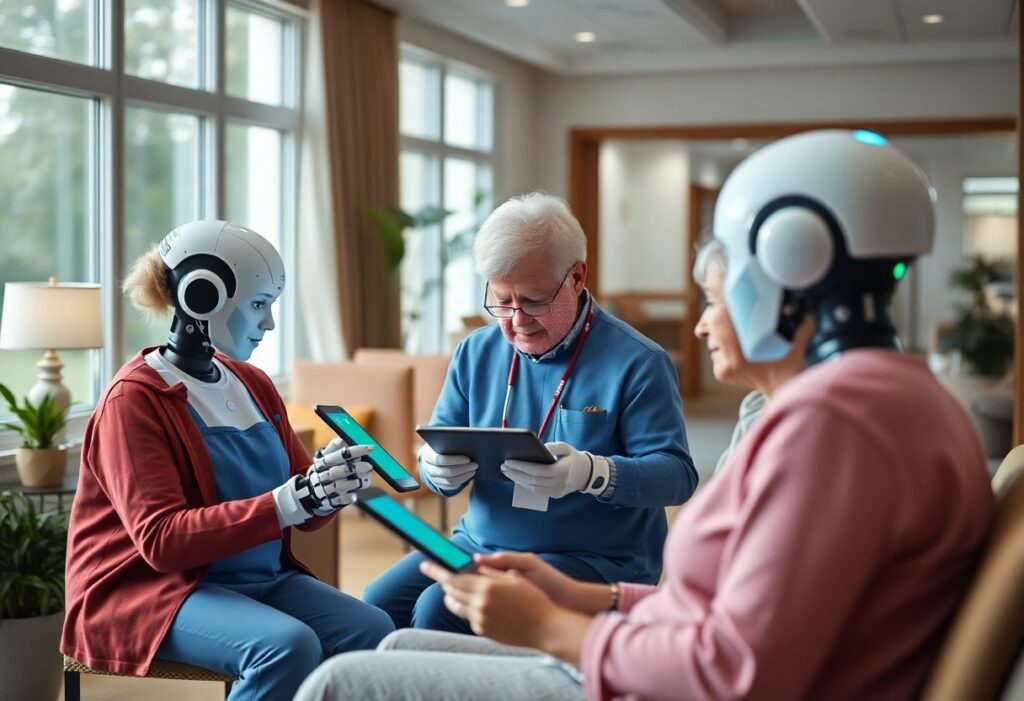Tools designed to streamline operations can vastly improve efficiency and quality of care within your senior care home. By leveraging automation, you can reduce administrative burdens, enhance communication, and automate routine tasks, allowing your team to focus on what truly matters—your residents. Discover how these innovative solutions can alter your daily workflow, leading to a more sustainable and responsive care environment. Explore the vital automation tools that will not only support your staff but also enrich the lives of those you care for.
Key Takeaways:
- Automation tools streamline administrative tasks, reducing time spent on paperwork and allowing staff to focus more on resident care.
- Integration of communication platforms enhances coordination among caregivers, families, and healthcare providers, improving overall service delivery.
- Data management systems enable better tracking of resident health metrics, facilitating proactive interventions and personalized care plans.

Understanding Automation Tools
Your senior care home can greatly benefit from the implementation of automation tools. These technologies streamline operations, enhance resident care, and ultimately lead to improved outcomes for both staff and residents. By integrating the right automation systems, you can reduce manual tasks and allow your staff to focus on what truly matters – providing exceptional care to your residents. Understanding the landscape of available tools is the first step towards transforming your facility’s operations.
How to Identify the Right Tools for Your Facility
To choose the most suitable automation tools for your senior care home, start by assessing your specific needs and challenges. Conduct a thorough evaluation of your current processes and identify areas where automation can bring about notable improvements. Engage with your staff to gather insights on their daily operations and pain points. Prioritizing your needs will help you focus on solutions that deliver the best return on investment and enhance overall efficiency.
Key Factors to Consider When Implementing Automation
Tools selection isn’t just about the technology itself; it involves considering various factors to ensure a smooth transition to automation. Prioritize user-friendliness, as a solution that is easy to understand will lead to higher staff adoption rates. Additionally, think about compatibility with your existing systems, as seamless integration is important for minimizing disruptions. Training and support options also play a significant role in a successful implementation. Here are some key considerations:
- User-friendliness: Ensure the solution is intuitive for staff.
- Compatibility: Check if the tool integrates well with your current systems.
- Training and support: Look for vendors who offer thorough training and ongoing assistance.
Recognizing these factors will help ensure a successful automation implementation, ultimately leading to greater efficiency and satisfaction within your facility.
Another aspect to consider is how the tools can support your team in providing care while juggling administrative tasks. Incorporating automation can significantly enhance communication between staff members, reduce paperwork, and even streamline scheduling processes. Consistent evaluation of tool performance is important to guarantee they continue to meet your facility’s needs effectively. Pay attention to aspects such as:
- Scalability: Ensure that the tools can grow alongside your facility.
- Cost-efficiency: Evaluate your budget against the potential time savings.
- Reliability: Choose reputable vendors with proven track records.
Recognizing these factors can significantly impact the effectiveness of your automation efforts, enabling you to focus more on improving resident care and operational efficiency.
Types of Automation Tools
You have a wealth of options when it comes to selecting automation tools for your senior care home. These tools can greatly streamline your operations, ensuring a more efficient care environment for both staff and residents. Popular types of automation tools include:
| Care Management Software | Helps in scheduling, tracking, and managing resident care. |
| Communication Tools | Facilitates seamless communication between staff, families, and residents. |
| Billing Systems | Automates the billing process and manages payments. |
| Health Monitoring Devices | Tracks vital signs and health metrics of residents. |
| Task Management Software | Organizes staff assignments and checks off tasks efficiently. |
This variety allows you to select the tools that best fit your operational needs and goals. By integrating these automation tools, you can enhance the quality of care and operational efficiency in your senior care home.
How to Choose Software Solutions for Senior Care
To select the appropriate software solutions for your senior care home, consider your specific needs and challenges. Analyze the features available in various systems—focus on those that support both staff efficiency and resident satisfaction. It’s beneficial to read reviews, and consult with other care facilities, and possibly demo the software before making a commitment.
Additionally, keep in mind your budget constraints and whether the software offers scalability for future growth. Look for solutions that provide strong customer support and user-friendly interfaces, as these elements can significantly impact your team’s ability to adapt and utilize the software effectively.
Tips for Integrating Physical Automation Devices
Careful integration of physical automation devices can greatly enhance the efficiency of operations in your senior care home. You should start by assessing which devices—such as automated medication dispensers, mobility aids, and monitoring systems—align with your operational goals. Train your staff thoroughly on how to use these devices to ensure a smooth transition.
- Prioritize staff training.
- Assess the space requirements for new devices.
- Ensure compatibility with existing software solutions.
- Gather feedback from residents and families about their experience.
- Monitor the impact on daily operations regularly.
This holistic approach will help maximize the benefits that automation devices can bring to your care home. Investing time in understanding these devices will pay off in smoother operations and better resident care.
It’s imperative to choose quality devices that enhance the overall care environment. Focus on those features that promote resident safety and comfort. Ensure devices are user-friendly for both staff and residents to prevent frustration. Moreover, be cautious about the security risks that some devices may pose if not properly integrated, as they connect to sensitive data systems.
- Conduct a thorough risk assessment.
- Choose devices with robust data protection.
- Establish protocols for equipment maintenance.
- Consider the environmental impact of selected devices.
- Regularly update your automation strategy as technology evolves.
This will ensure that your integration of physical automation devices is successful and contributes positively to the quality of care you provide.
Training and Support
Not every staff member may feel confident or comfortable with the implementation of new technologies in your senior care home. To mitigate any potential resistance or difficulties, it is vital to provide comprehensive training and support. This training should not only cover how to use the new tools but also emphasize their benefits for both staff and residents. Creating a culture that embraces technology can lead to enhanced care delivery, improved job satisfaction, and a smoother transition for everyone involved.
How to Prepare Staff for New Technologies
Any successful transition to new technologies begins with assessing your staff’s comfort level and identifying skill gaps. Hosting initial workshops or informal training sessions can be beneficial. In these settings, you can demonstrate the technology’s functionalities while addressing any possible challenges. Pairing less tech-savvy employees with more experienced peers for hands-on guidance fosters a supportive learning environment, enhancing the overall adoption rate within your team.
Tips for Ongoing Training and Support
Even after the implementation phase, providing continuous support and training is vital for maintaining proficiency and confidence in using strong technologies. Consider establishing a regular schedule for follow-up training sessions, refresher courses, or team meetings to discuss best practices. Encourage staff to share tips and experiences with each other. Utilize various formats, such as online tutorials, peer mentoring, and printed guides, to yield the best results. This will ensure that the staff remains engaged and competent in using the technologies that benefit your senior care home.
- Establish a regular schedule for strong training sessions
- Encourage staff to share tips and strong experiences
- Utilize online tutorials and strong printed guides
Technologies like tracking systems, automatic medication dispensers, and health monitoring tools can significantly revolutionize the way care is provided in senior care homes. Continual training ensures that you and your team can take full advantage of these advancements, improving both your operation’s efficiency and the quality of service provided to your residents. This ongoing commitment to training reflects not only on your operational success but also on the satisfaction and well-being of those you serve.
- Utilize strong tracking systems and tools
- Focus on strong staff engagement and satisfaction
- Reflect commitment to strong quality service

Measuring Success
For any automation strategy to be truly effective, you must assess its impact on your senior care home’s operations. One of the most effective ways to achieve this is by implementing a systematic approach to tracking the outcomes of your automation initiatives. By using dedicated software tools, you can gather data on various operational processes, identify bottlenecks, and evaluate improvements in staff efficiency as well as resident satisfaction. With this structured framework in place, you will have the insights necessary to continuously refine your automation strategies and ensure that they align with the goals of your care home.
How to Track the Impact of Automation on Operations
Clearly, measuring the impact involves more than just collecting data; it requires analysis and interpretation. Start by establishing baseline metrics prior to implementing any automation tools, enabling you to draw meaningful comparisons over time. You can leverage dashboards and analytics platforms that provide visual representations of your data, allowing for immediate identification of trends. Regularly review this data with your team to understand how automation is influencing key operations, such as medication management or communication protocols, which ultimately leads to improved resident outcomes.
Key Performance Indicators to Monitor
Assuming you have set up your metrics, it’s important to define the Key Performance Indicators (KPIs) that will inform your evaluation process. Some KPIs to consider include staff time saved, reduction in errors, resident satisfaction scores, and response time to emergencies. Each of these indicators will help you paint a picture of how well your automation efforts are integrating into daily operations. More importantly, they will highlight areas that may still require attention, allowing you to pivot quickly to address shortcomings.
Automation can dramatically enhance the performance of your senior care home by providing you with important data that informs your operational decisions. Tracking KPIs such as staff efficiency, resident engagement, and incident reduction not only allows you to gauge the success of your automation tools but also helps you prioritize areas for continuous improvement. By focusing on these indicators, you ensure ongoing enhancements that will positively impact both your staff’s workflow and the quality of care provided to your residents.
Overcoming Challenges
To successfully integrate automation tools into your senior care home’s operations, you will encounter various challenges that must be addressed promptly. As you navigate through this transformation, it’s vital to recognize that resistance to change can arise due to skepticism from staff, patients, and families. Therefore, being proactive in educating your team on the benefits of automation can lead to a smoother integration. For more insights, check out AI Automation in Home Care: 15 Processes You Must … to see how these tools can improve care delivery and operational efficiency.
How to Address Resistance to Change
Little victories can make a significant difference in your approach to overcoming resistance. Open communication with your staff about the reasons behind implementing automation technologies is crucial. Encourage their input and feedback to foster an environment where they feel involved in the change process. This inclusion can alleviate concerns and empower your staff, ultimately driving a more accepting attitude towards adjustments.
Tips for Ensuring a Smooth Transition
There’s no denying that implementing new automation tools requires careful planning to ensure a seamless transition. Start by laying a strong foundation for your project by engaging key stakeholders and offering targeted training sessions. In addition, consider establishing a dedicated team to oversee the implementation process, ensuring that your staff knows what to expect and feels supported. Here are additional tips to make the transition smoother:
- Encourage open lines of communication among your staff to express concerns and suggestions.
- Provide comprehensive training on the new systems and tools.
- Consider a phased rollout to mitigate overwhelming your team.
- Regularly monitor progress, allowing space for adjustments and feedback.
It is crucial to keep your team informed and motivated throughout the transition. Staying positive and providing updates on the integration process can reinforce your commitment to improving their work environment with enhanced automation solutions. Being adaptable and ready to adjust strategies will help in addressing any unforeseen challenges. Here are some additional key actions to ensure a successful transition:
- Share success stories to boost morale and buy-in from your employees.
- Establish metrics for evaluating the impact of the new tools.
- Offer ongoing technical support to address any issues that may arise.
- Solicit feedback to refine the process and improve user experience.
Any successful implementation hinges on your ability to guide the team through this pivotal change, fostering a culture of adaptability and growth.
Future Trends in Senior Care Automation
Despite the challenges posed by an aging population and the increasing demand for efficient senior care, the future of automation in this sector looks promising. The integration of advanced technologies is set to revolutionize your operations, making them more efficient and responsive. For example, innovations like artificial intelligence and machine learning are poised to enhance personalized care by analyzing patient data to predict health outcomes. Additionally, robotic assistance is becoming commonplace, helping staff to manage physical tasks while ensuring that residents receive the individual attention they deserve. For more insights on these advancements, take a look at 5 Technologies Transforming Senior Healthcare.
How to Stay Ahead of Technological Advances
An imperative part of thriving in the ever-evolving landscape of senior care automation is staying informed about new technological advances. This could involve regularly attending industry conferences, participating in webinars, or subscribing to relevant publications. By cultivating a continuous learning mindset, you can identify opportunities for innovation that align with your care home’s mission and values. Networking with other professionals in your field can also provide valuable insights and best practices that will help you remain competitive in an increasingly technology-driven environment.
Tips for Adapting to New Developments
An effective approach to adapting to new developments in senior care automation involves not just understanding the technology but also considering how it can be implemented in your operations. Here are some tips to keep in mind:
- Assess the specific needs of your residents and staff when choosing automation tools.
- Invest in training programs for your staff to ensure they are proficient with new technologies.
- Solicit feedback from your team about which tools enhance their workflow and resident care.
Any shifts in technology require a thoughtful approach to integration, ensuring that both residents and staff benefit from these advancements.
It’s important to encourage a culture of flexibility within your team when implementing new developments. This involves engaging your staff in discussions about how to best incorporate technology in ways that respect the unique needs of your residents. Creating a supportive atmosphere where team members can express concerns or suggestions will also facilitate smoother transitions to new tools. Consider the following steps:
- Initiate pilot programs to test new tools before a full-scale rollout.
- Provide comprehensive training sessions that empower staff to become technology advocates.
- Monitor and evaluate the impact of automation on staff workload and resident satisfaction.
Any implementation process you undertake should prioritize both operational efficiency and the quality of care provided to residents.

Final Words
Hence, embracing automation tools in your senior care home can significantly enhance your operational efficiency and the quality of care you provide. By utilizing innovative solutions for scheduling, patient management, and communication, you can streamline processes that may have previously been time-consuming or cumbersome. As you adopt these technologies, you not only reduce administrative burdens but also create more opportunities for meaningful interactions with residents, which is necessary in a senior care setting.
Ultimately, the transformation brought about by automation tools will empower you to focus more on what truly matters: the well-being of your residents. Investing in these technologies not only optimizes your resources but also positions your facility as a forward-thinking home that prioritizes both operational excellence and compassionate care. By equipping yourself with the right tools, you ensure that your care home can better meet the needs of seniors and adapt to the evolving demands of the industry.
FAQ
Q: What types of automation tools can improve daily operations in a senior care home?
A: There are several automation tools designed to enhance the efficiency of senior care home operations. These include Electronic Health Record (EHR) systems that streamline patient documentation, Scheduling software that organizes staff shifts and resident activities, and Medication management systems that help track prescriptions and dosage schedules. Additionally, communication platforms facilitate better coordination among staff, families, and residents. Implementing these tools can lead to improved care delivery and enhanced administrative efficiency.
Q: How can automation enhance the quality of care provided to residents?
A: Automation can significantly enhance the quality of care in senior living facilities by reducing the time staff spend on administrative tasks, allowing them to focus more on direct resident care. With automated scheduling, caregivers can ensure that residents receive timely assistance based on their individual needs. Additionally, real-time data tracking can help identify health trends among residents, enabling proactive interventions. This can help ensure that residents receive personalized and attentive care that meets their evolving needs.
Q: What are some challenges in implementing automation tools in senior care homes and how can they be overcome?
A: Implementing automation tools can present challenges such as resistance to change from staff, the need for training on new systems, and potential upfront costs. To overcome these challenges, it is imperative to involve staff in the decision-making process, ensuring that their concerns are heard and addressed. Providing comprehensive training sessions can help ease the transition to new technology. Additionally, exploring phased implementation strategies can minimize disruption while gradually integrating new tools. It’s also beneficial to highlight the long-term cost savings and benefits of improved care that these tools can provide.







